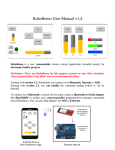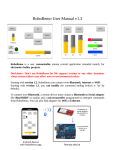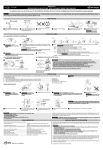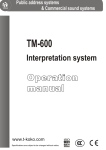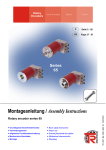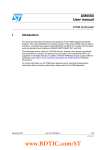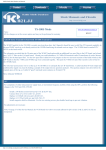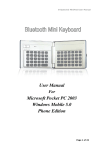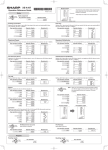Download ADP-001 - TR-Electronic GmbH
Transcript
Programmable absolute encoder display Manual ADP-001 Art-Nr.: 485-00220 Edition-/Rev.-Date: Document-/Rev.-Nr.: Firmware version: Filename: Author: 23.05.2000 TR - E - BA - GB - 0017 - 00 TR-E-BA-GB-0017.DOC MÜJ TR - Electronic GmbH Eglishalde 6 D-78647 Trossingen Telefon Telefax 07425 / 228-0 07425 / 228-33 Absolute Encoder Display ADP-001 ELECTRONIC GmbH TR-Electronic GmbH D-78647 Trossingen Eglishalde 6 Tel.: (0049) 07425/228-0 Fax: (0049) 07425/228-33 Copyright 1999 TR-Electronic Warranty For delivered products our "Allgemeine Lieferungs- und Zahlungsbedingungen" are effective. In no event TR-Electronic or its suppliers shall be liable for any other damages whatsover (including, without limitation, damages for loss of business profits, business interruption or other pecuniary loss) arising out of or inability to use this product. All products from TR-Electronic are warranted against defective material and workmanship for a period of one (1) year from date of delivery. If it is necessary to return the product to TR, the sender is responsible for shipping charges, freight, insurance and proper packaging to prevent breakage in transit. TR's warranty does not apply to defects resulting from action of the buyer, such mishandling, improper interfacing, operation outside of design limits, improper repair or unauthorized modification. Trademarks All trademarks that are named or portrayed in the text are registered trademarks of its owner. The trademarks are recognized by TR-Electronic. TR - ELECTRONIC GmbH, Unternehmensweites Qualitätsmanagement, Eglishalde 6, 78647 Trossingen, Tel. 07425-228-0, Fax 07425-228-33 Datum: 23.05.2000 TR - E - BA - GB - 0017 - 00 CONTENTS 1. Description . . . . . . . . . . . . . . . . . . . . . . . . . . . 4 2. Safety instructions . . . . . . . . . . . . . . . . . . . . . . . 5 2.1. Symbol explanation . . . . . . . . . . . . . . . . . . . . 5 3. Mounting . . . . . . . . . . . . . . . . . . . . . . . . . . . . 6 3.1. Place of operation . . . . . . . . . . . . . . . . . . . . . 6 3.2. Mounting of signal converter . . . . . . . . . . . . . . . . 6 4. Electrical connections . . . . . . . . . . . . . . . . . . . . . 7 4.1. General instructions . . . . . . . . . . . . . . . . . . . . 7 4.2. Hints against noisy environment . . . . . . . . . . . . . . 7 4.3. Connection and pin assignment . . . . . . . . . . . . . . 8 4.4. Connection of absolute encoder . . . . . . . . . . . . . . 9 4.5. Connection of digital user inputs . . . . . . . . . . . . . . 9 4.6. Connection of alarm outputs (relay) . . . . . . . . . . . . 9 4.7. Connection of analog output . . . . . . . . . . . . . . . . 10 4.8. Connection of power supply voltage . . . . . . . . . . . . 10 4.8.1. Supply voltage 18 ... 36 V DC . . . . . . . . . . . 10 5. Startup procedure . . . . . . . . . . . . . . . . . . . . . . . 10 6. Pushbuttons- and LED-functions . . . . . . . . . . . . . . . 11 6.1. Function of buttons and LEDs . . . . . . . . . . . . . . . 11 7. Modes . . . . . . . . . . . . . . . . . . . . . . . . . . . . . . 12 7.1. Operation level . . . . . . . . . . . . . . . . . . . . . . . 12 7.2. Access-code level . . . . . . . . . . . . . . . . . . . . . 13 7.3. Programming level . . . . . . . . . . . . . . . . . . . . . 14 8. Procedure of programming . . . . . . . . . . . . . . . . . . 15 8.1. Changing or controlling parameters . . . . . . . . . . . . 15 8.2. Overview of the programming levels . . . . . . . . . . . 16 8.3. Programming level for configuration P-00 . . . . . . . . . 17 8.3.1. Scaling the display range . . . . . . . . . . . . . 19 8.4. Programming level of alarms P-02 . . . . . . . . . . . . 20 8.4.1. Alarm output functions . . . . . . . . . . . . . . . 21 TR - Electronic GmbH 2 8.4.2. Alarm high setpoint . . . . . . . . . . . . . . . . 22 8.4.3. Alarm low setpoint . . . . . . . . . . . . . . . . . 22 8.5. Programming level for analog output P-03 . . . . . . . . 23 8.5.1. Scaling of the analog output . . . . . . . . . . . . 23 8.5.2. Analog output at failure Indication . . . . . . . . 23 8.5.3. Analog output at overflow resp. underflow . . . . 24 8.6. Programming quick reference . . . . . . . . . . . . . . . 25 9. Software functions . . . . . . . . . . . . . . . . . . . . . . . 27 9.1. Master/Slave-Mode . . . . . . . . . . . . . . . . . . . . 27 9.2. Zero point adjustment . . . . . . . . . . . . . . . . . . . 27 9.2.1. Zero point adjustment by pressing button . . . . . 27 9.2.2. Zero point adjustment by offset value . . . . . . . 28 9.3. Incremental measurement . . . . . . . . . . . . . . . . . 29 9.4. Direction of rotation . . . . . . . . . . . . . . . . . . . . 29 9.5. MIN/MAX value detection . . . . . . . . . . . . . . . . . 29 9.6. Hold function . . . . . . . . . . . . . . . . . . . . . . . . 30 9.7. Display test . . . . . . . . . . . . . . . . . . . . . . . . 30 9.8. Main reset . . . . . . . . . . . . . . . . . . . . . . . . . 31 10. Error codes . . . . . . . . . . . . . . . . . . . . . . . . . . . 31 10.1. Encoder not connected “Err01" . . . . . . . . . . . . . . 31 10.2. Waiting for data input “Err02" . . . . . . . . . . . . . . . 31 10.3. External clock frequency too high “ERR03" . . . . . . . . 31 11. Technical Specifications . . . . . . . . . . . . . . . . . . . . 32 11.1. Electrical datas . . . . . . . . . . . . . . . . . . . . . . 32 11.2. Mechanical datas . . . . . . . . . . . . . . . . . . . . . 32 11.3. Environmental conditions . . . . . . . . . . . . . . . . . 33 Stand : 23.05.2000 TR-E-BA-GB-0017-00.DOC Technical subjects to change 3 TR - Electronic GmbH 1. Description 1. Description The programmable absolut encoder display ADP-001 is an instrument to convert datas of absolute encoders with Synchronous-Serial-Interface (SSI) in an analog output signal. Simultaneous, it can carried out an alarm point controlling. Standard hardware • isolated analog output 0 - 10 V, 2 - 10 V, 0 - 20 mA, 4 - 20 mA • two relay alarm outputs • two programmable digital input channels • three programmable pushbuttons Standard software • Programming of encoder datas • Scaling-factor • Zero point adjustment • Offset value • Display segment test • Hold function • MAX/MIN value detection • Auto-Reset of MAX/MIN value • Edit of the alarm value during normal measurement • Display of error messages TR - Electronic GmbH 4 2. Safety instructions 2. Safety instructions This instrument is produced in accordance with Class II of IEC 348 and VDE 0411. When delivered the instrument has been tested to meet all functions described. Before installing the instrument please read the mounting and servicing instructions. We have no liability or responsibility to customer or any other person or entity with respect to any liability, loss or damage caused or alleged to be caused directly or indirectly by equipment or software sold or furnished by us. Read the installation instruction carefully. No liability will be assumed for any damage caused by improper installation. Inspect the instrument module carton for obvious damage. Be shure there are no shipping and handing damages on the module before processing. Do not apply power to the instrument if it has been damaged. TR’s warranty does not apply to defects resulting from action of the buyer, such as mishandling, improper interfacing, operation outside of design limits, improper repair or unauthorized modifications. 2.1. Symbol explanation Caution Attention Instruction Caution: Will be used at dangerous for life and health ! Attention: Will cause damage Instruction: If not noticed, trouble may occur Tip: Useful hints for better operation 5 Tip TR - Electronic GmbH 3. Mounting 3. Mounting 3.1. Place of operation Attention must be payed to the protection against humidity, dust and high temperatures at the place of operation. 3.2. Mounting of signal converter • through simple snap up at 35 mm rail (DIN EN 50022) LED1 LED2 LED3 105 110 P 70 TR - Electronic GmbH 6 4. Electrical connections 4. 4.1. Electrical connections General instructions • It is forbidden to plug or unplug connectors with voltage applied • Attach input and output wires to the connectors only without voltages applied • Cords must be provided with sleeves • Attention must be paid that the power supply voltage applied will agree with voltage noticed at the name plate. • The instrument has no power-on switch, so it will be in operation as soon as the power is connected. 4.2. Hints against noisy environment All inputs and outputs are protected against noisy environment and high voltage spikes. Nevertheless the location should be selected to ensure that no capacitive or inductive interference can have an effect on the instrument or the connection lines. It is advisable: • To use shielded cables. • The wiring of shields and ground (0V) should be star-shaped. • The distance to interference sources should be as long as possible. If necessary, protective screen or metal enclosures must be provided. • Coils of relays must be supplied with filters. • Parallel wiring of input signals and AC power lines should be avoided. 7 TR - Electronic GmbH 4. Electrical connections 4.3. Connection and pin assignment All inputs and outputs are connectors, designed as plug-in screw terminals. signal input n.c. digital inputs 26 25 24 23 22 21 20 19 18 17 16 15 14 LED1 LED2 LED3 P 1 2 + - 3 4 5 6 7 8 9 10 11 12 13 n.c. alarm 1 alarm 2 analog output Pin assignment: 1 Power supply DC (+) 14 SSI-Signalinput, Clock (+) 2 Power supply DC (-) SSI-Signalinput, Clock (-) 3 Ground connection 4 Analog output 0/2-10 V (+) 5 Analog output 0/4-20 mA (+) 6 Analog output, GND (-) 15 16 17 18 19 10/11 Alarm (relay) output 1 24 Digital user input 1 12/13 Alarm (relay) output 2 25 26 Digital user input 2 Digital GND TR - Electronic GmbH SSI-Signalinput, Data (+) SSI-Signalinput, Data (-) SSI-Signalinput, GND (0 V) Ground connection 8 4. Electrical connections 4.4. Connection of absolute encoder Clock + Clock - Data+ Data- (GND) Encoder 26 25 24 23 22 21 20 19 18 17 16 15 14 4.5. Connection of digital user inputs 26 25 24 23 22 21 20 19 18 17 16 15 14 Digital input 1 • active => Connecting Screw Terminal 24 to 26 • Connecting to Ground, low active Digital input 2 • active => Connecting Screw Terminal 25 to 26 • Connecting to Ground, low-active 4.6. Connection of alarm outputs (relay) 1 2 3 4 5 6 7 8 9 10 11 12 13 alarm 1 alarm 2 9 TR - Electronic GmbH 5. Startup procedure Connection of analog output 3 4 4.8. 5 6 7 8 9 10 11 12 13 A- 2 AU+ 1 AI+ 4.7. Connection of power supply voltage 4.8.1. Supply voltage 18 ... 36 V DC 5. 1 2 + - 3 4 5 6 7 8 9 10 11 12 13 Startup procedure Attention must be paid that the power supply voltage applied will agree with the voltage noticed at the name plate. Switch the power supply on (supply voltage applied to screw terminal 1 and 2). After about 2 seconds the display will indicate the applied input signal. When delivered, the instrument is programmed with a standard configuration (default values). By programming the customer can change the standard configuration according to his measuring task. Attention ! When the instrument is built in a machine and the customer wants to change the configuration, attention must be paid, that no damage will occur to the machine! TR - Electronic GmbH 10 6. Pushbuttons- and LED-functions 6. Pushbuttons- and LED-functions There are four push buttons in the front. These push buttons can have different functions. The functions of the push buttons can be used for programming and for service. 6 decades display LED1 LED1 LED2 LED2 LED3 LED3 P function button programming button button "-" / alarm 1 / alarm 2 direct input-, max- ,minor hold value button "+" / alarm 1 / alarm 2 direct input-, max- ,minor hold value 6.1. LED 1 x x x x x x x x off lights flashs flashs Function of buttons and LEDs LED 2 x x x x off lights flashs flashs x x x x LED 3 off red green green/flashs x x off green/flashs x x off green/flashs Description encoder- or hold value is displayed MIN value is displayed MAX value is displayed programming mode is activated alarm 2 is not activated alarm 2 is activated alarm point 2 is displayed alarm point 2 is changed alarm 1 is not activated alarm 1 is activated alarm point 1 is displayed alarm point 1 is changed x = state of the LED is not considered 11 TR - Electronic GmbH 7. Modes 7. Modes The operation and the programming of the panel meter is organized in several states: • Operation level • Access-code level • Programm level 7.1. Operation level In the state “operation level” the normal functions of the instrument are activated. A normal measurement cycle looks like below: • Read the value of encoder, calculate and display • Evaluate the digital inputs • Alarm outputs • Analog output Dependent on the programming of the parameter 0-14 (function of key (function of key ) and 0-13 (function of key available in the operation level. Parameter 0-13 Function of pushbutton “*” 0 1 2 3 4 5 Parameter 0-14 Function of pushbutton “-” 0 1 2 3 4 5 6 TR - Electronic GmbH ), 0-15 ), following key-functions are By pressing No function Reset the MIN/MAX value Taring Clear tara value Incremental measurement Manual reset of alarms By pressing No function Display value of encoder Display MAX value Display MIN value Display hold value Display alarm point 1 Display alarm point 2 Pressing during 3 sec. Change alarm point 1 Change alarm point 2 12 7. Modes Parameter 0-15 Function of pushbutton “+” 0 1 2 3 4 5 6 7.2. By pressing No function Display value of encoder Display MAX value Display MIN value Display hold value Display alarm point 1 Display alarm point 2 Pressing during 3 sec. Change alarm point 1 Change alarm point 2 Access-code level The state “access-code level” becomes active by pressing the pushbutton P during the state “operation level”. The display shows “c000". During the state ”access-code level" the normal functions of the instrument are active. pushbutton P Function Confirm of the displayed access-code Increase the access-code Decrease the access-code Programmed function 13 TR - Electronic GmbH 7. Modes 7.3. Programming level The state “programm level” becomes active by entering the right access-code. The access-code must be confirm by pressing the pushbutton P . The programming is organized in following steps: • Selection of a programming level • Selection of a parameter • Change of the selected parameter Pushbutton P Press Selection of - Programming level - Parameter Decrease of - Programming level - Number of parameter - Value of parameter Increase of - Programming level - Number of parameter - Value of parameter - TR - Electronic GmbH Pressing during 3 sec. - - Break the programming routine 14 8. Procedure of programming 8. Procedure of programming The procedure of programming is organized in several different steps. Access to the selection of the programming levels • Pressing pushbutton P => access-code enter is active • The display shows “c000" • Changing the access-code by pressing the pushbutton or and confirm the changed access-code by pressing the pushbutton P If the entered access-code is not correct, the instrument will jump back to the state “operation level”. 8.1. Changing or controlling parameters Activating the programming routine • Pressing pushbutton P • LED 3 flashs green • The display shows “c000" • Changing the access-code by pressing the pushbutton or • Confirm access-code by pressing the pushbutton P • The display shows “P-00" Leaving the programming routine • Pressing the pushbutton or until the display shows “PEnd” • Confirm the display “PEnd” by pressing the pushbutton P • LED 3 is off • The active state of the panel meter is “operation level” Selection of the programming level • Selecting the programming level by pressing the pushbutton or • Confirm the programming level by pressing the pushbutton P • The display shows the number of the parameter of the selected programming level For example: “0-00" => parameter 0 of the programming level 0 For example: ”2-00" => parameter 0 of the programming level 2 15 TR - Electronic GmbH 8. Procedure of programming Leaving the programming level • Pressing the pushbutton or until the display shows “xEnd” For example: “0End” => leaving programming level 0 For example: “2End” => leaving programming level 2 • Confirm the display “xEnd” by pressing the pushbutton P • The display shows the programming level For example: “P-00" => for programming level 0 For example: ”P-02" => for programming level 2 Selection of the parameter • Selection the parameter by pressing the pushbutton or • Confirm the parameter by pressing the pushbutton P • The display shows the last programmed value of the selected parameter Change and controll the selected parameter • Change the value of the parameter by pressing the pushbutton or • Confirm the value of the parameter by pressing the pushbutton P • The display shows the programming level and the number of the parameter For example: “0-05" => parameter number 5 of programming level 0 For example: ”2-08" => parameter number 8 of programming level 2 8.2. Overview of the programming levels The parameters of the panel meter are organized in different programming levels. P-00: Programming level for configuration of the panel meter The configuration is used to adapt the absolute encoder and the panel meter. P-02: Programming level for the alarms This programming level is used to programm all settings for the alarm outputs. P-03: Programming level for the analog output This programming level is used to programm all settings of the analog output. TR - Electronic GmbH 16 8. Procedure of programming 8.3. Param. 0-00 0-01 0-02 0-03 0-04 0-05 0-06 0-07 0-08 0-09 0-10 0-11 17 Programming level for configuration P-00 Description Resolution (Bits) Output code 0 -> Gray 1 -> Binary Master/Slave-Mode 0 -> Instrument = Master 1 -> Instrument = Slave Clock for Master-Mode 0 -> Frequency = 200 kHz 1 -> Frequency = 100 kHz Zero adjustment 0 -> Zero adjustment without sign 1 -> Zero adjustment with ± display Counting direction 0 -> increasing clockwise rotation 1 -> increasing anticlockwise rotation Scalingfactor Offset value Programmable decimal points 0 -> XXXXXX 1 -> XXXXX.X 2 -> XXXX.XX 3 -> XXX.XXX 4 -> XX.XXXX 5 -> X.XXXXX Data source of the display 0 -> Encoder value 1 -> MAX value 2 -> MIN value 3 -> Hold value Reset time of the MIN/MAX value 0 -> No automatically reset X -> Reset time in seconds Function of digital user input 1 0 -> No function 1 -> Reset MIN/MAX value 2 -> Taring of encoder 3 -> Clear tara value of encoder 4 -> Incremental measurement 10 .. 25 Default value 12 0 .. 1 0 0 .. 1 0 0 .. 1 0 0 .. 1 0 0 .. 1 0 0.00001 .. 9.99999 -99999 .. 999999 1.00000 0 0 .. 5 0 0 .. 3 0 0 .. 100 0 0 .. 10 0 Setting range TR - Electronic GmbH 8. Procedure of programming continue of 0-11: 0-11 0-12 0-13 0-14 0-15 0-19 0End Function of digital input 1 5 -> Manual reset of alarms 6 -> Hold function 7 -> Display test 8 -> Display value of encoder 9 -> Display MAX value 10 -> Display MIN value Function of digital user input 2 0 -> No function 1 -> Reset MIN/MAX value 2 -> Taring of encoder 3 -> Clear tara value of encoder 4 -> Incremental measurement 5 -> Manual reset of alarms 6 -> Hold function 7 -> Display test 8 -> Display value of encoder 9 -> Display MAX value 10 -> Display MIN value Function of push button “*” 0 -> No function 1 -> Reset MIN/MAX value 2 -> Taring of encoder 3 -> Clear tara value of encoder 4 -> Incremental measurement 5 -> Manual reset of alarm Function of pushbutton “-” 0 -> No function 1 -> Display value of encoder 2 -> Display MAX value 3 -> Display MIN value 4 -> Display hold value 5 -> Display/change alarm point 1 6 -> Display/change alarm point 2 Function of pushbutton “+” 0 -> No function 1 -> Display value of encoder 2 -> Display MAX value 3 -> Display MIN value 4 -> Display hold value 5 -> Display/change alarm point 1 6 -> Display/change alarm point 2 Access-code Leaving programming level 0 TR - Electronic GmbH 0 .. 10 0 0 .. 10 0 0 .. 5 0 0 .. 6 0 0 .. 6 0 0 .. 999 0 18 8. Procedure of programming 8.3.1. Scaling the display range The scaling of the display range is matched by using a scaling-factor and an offset value. The calculation of the display value looks like below: Display = (Enc_value - Zero_adjustmet) x Sca_faktor + Offset value The overflow or underflow becomes active, if the displayed value is greater than 999999 or smaller than -99999. • When overflow is activ the display shows “nnnnnn” • When underflow is active the display shows “uuuuuu” 19 TR - Electronic GmbH 8. Procedure of programming 8.4. Programming level of alarms P-02 Param. 2-00 2-01 2-02 2-03 2-04 2-05 2-06 2-07 2-08 2-09 2-10 2-11 2End Description Alarm output 1, data source 0 -> Alarm 1 off 1 -> Alarm 1 to value of encoder 2 -> Alarm 1 to maximum value 3 -> Alarm 1 to minimum value 4 -> Alarm 1 to hold value Alarm output 1, high or low 0 -> Contact closed by low limit 1 -> Contact closed by high limit 2 -> Contact open by low limit 3 -> Contact open by high limit Alarm output 1, alarm point Alarm output 1, hysteresis Alarm output 1, release delay time in seconds Alarm output 1, operate delay time in seconds Alarm output 2, data source 0 -> Alarm 2, off 1 -> Alarm 2 to value of encoder 2 -> Alarm 2 to maximum value 3 -> Alarm 2 to minimum value 4 -> Alarm 2 to hold value Alarm output 2, high or low 0 -> Contact closed by low limit 1 -> Contact closed by high limit 2 -> Contact open by low limit 3 -> Contact open by high limit Alarm output 2, alarm point Alarm output 2, hysteresis Alarm output 2, release delay time in seconds Alarm output 2, operate delay time in seconds Leave programming level P-02 TR - Electronic GmbH Setting range Default value 0 .. 4 0 0 .. 3 0 -99999 .. 999999 1 .. 1000 0 1 0 .. 60 0 0 .. 60 0 0 .. 4 0 0 .. 3 0 -99999 .. 999999 1 .. 1000 0 1 0 .. 60 0 0 .. 60 0 20 8. Procedure of programming 8.4.1. Alarm output functions Data sources of the alarms: • Value of the encoder • Maximum value • Minimum value • Hold value Indication of alarms • Two relay output • LED 1 and LED 2 at the front Programmable functions of the alarms • Alarm value • Hysteresis • Release delay time and operate delay time • High or low alarm Manual alarm reset In dependence of programming the digital inputs and the functional pushbutton is the alarm output latched or not latched. Alarm output latched: • If the digital input 1, 2 (parameter 0-11 and 0-12) or the functional pushbutton (parameter 0-13) is programmed to manual alarm reset • Reset the latched alarm output by activate the digital inputs or press the functional pushbutton Alarm output not latched: • If the digital inputs and the functional pushbutton manual alarm reset are not programmed to Display and edit the alarm values • Inside the programmig routine, which is reached over the enter code. During the programming routine no measurement is taken. • Outside the programming routine by pressing the pushbutton normal measurement are taken. The edition is end when pressing the pushbutton will be up to date. 21 or during P . Therfore the alarm value TR - Electronic GmbH 8. Procedure of programming 8.4.2. Alarm high setpoint LED normally closed to high limit LED LED t LED LED LED normally opened to high limit t alarm value alarm valuehysteresis alarm watched signal operate delay time t release delay time 8.4.3. Alarm low setpoint LED normally closed to low limit LED LED t normally opened to low limit LED LED LED t alarm value + hysteresis alarm value alarm watched signal operate delay time TR - Electronic GmbH release delay time t 22 8. Procedure of programming 8.5. Programming level for analog output P-03 Param. 3-00 3-01 3-02 3-03 3End Description Analog Output, data source 0 -> Value of encoder to analog output 1 -> MAX value to analog output 2 -> MIN value to analog output 3 -> Hold value to analog output Analog Output, configuration 0 -> 0 to 10 V 1 -> 2 to 10 V 2 -> 0 to 20 mA 3 -> 4 to 20 mA Display value for minimal analog output signal Display value for maximal analog output signal Leave programming level P-03 Seeting range Default value 0 .. 3 0 0 .. 3 0 -99999 .. 999999 0 -99999 .. 999999 4095 8.5.1. Scaling of the analog output The scaling of the analog output range can be programmed with the parameter 3-02 and 3-03. Any value between -99999 and 999999 can be set to minimal and maximal analog output signal. Data sources of the analog output: • Value of encoder • Maximum value • Minimum value • Hold value 8.5.2. Analog output at failure Indication Output signal Voltage 0 to 10 V Voltage 2 to 10 V Current 0 to 20 mA Current 4 to 20 mA 23 Output value by “Err01" 0V 1V 0 mA 2 mA Output value by ”Err02" and “Err03" current value won´t be changed TR - Electronic GmbH 8. Procedure of programming 8.5.3. Analog output at overflow resp. underflow Output signal Voltage 0 to 10 V Voltage 2 to 10 V Current 0 to 20 mA Current 4 to 20 mA TR - Electronic GmbH Output value by overflow 10 V 10 V 20 mA 20 mA Output value by underflow 0V 2V 0 mA 4 mA 24 8. Procedure of programming 8.6. Programming quick reference P (wrong access-code) c000 P P (right access-code) - d - 3 2 P-00 P 1 + + + + + + + + + + + + + + + + + P3 25 - 0-00 0-01 0-02 0-03 0-04 0-05 0-06 0-07 0-08 0-09 0-10 0-11 0-12 0-13 0-14 0-15 0-16 0End P P P P P P P P P P P P P P P P P 1 2 Resolution (bits) Output code: gray or binary Master/Slave-mode Clock for Master-mode Zero-adjustment Counting direction Display-multiplier Offset-value Programmable points Data source of the display Reset time of max-, min- and hold value Function of digital input 1 Function of digital input 2 + - 6 P-02 5 P 4 + + + + + + + + + + + + P6 - 2-00 2-01 2-02 2-03 2-04 2-05 2-06 2-07 2-08 2-09 2-10 2-11 2End + P P P P P P P P P P P P 4 5 Data source of alarm 1 Alarm 1, high or low Value of alarm 1 Hysteresis of alarm 1 Fall off time of alarm 1 Put on time of alarm 1 Data source of alarm 2 Alarm 2, high or low Value of alarm 2 Hysteresis of alarm 2 Fall off time of alarm 2 Put on time of alarm 2 + Function of key "*" Function of key "-" Function of key "+" -access-code + TR - Electronic GmbH 8. Procedure of programming operation level -8 P 7 3-00 3-01 3-02 3-03 3End + + + + P9 + - P-03 9 - P P Data source of analog output P P Display value for minimal output signal Display value for maximal output signal 7 8 P PEnd + 3 d Analog output signal + description TR - Electronic GmbH P pressing the button P + pressing the button - pressing the button 26 9. Software functions 9. 9.1. Software functions Master/Slave-Mode Master-Mode Parameter 0-02 have to be programmed to 0 For reading the value of the encoder the clock is generated by the instrument. The clock frequency can be programmed to 100 kHz or 200 kHz. (parameter 0-03) Slave-Mode: Parameter 0-02 have to be programmed to 1 The clock signal have to be generated by an other instrument. The data transmission between the encoder and the instrument dependent on this “external clock”. In slave mode attention should be paid to: • External clock may not exceed 125 kHz • Pause of clock brushs have to be min. 500 µs • The encoder value will be displayed with 28 values per second 9.2. Zero point adjustment Sometimes an exactly mechanical zero point adjustment isn´t possible. But it´s possible to adjust the zero point by software. 9.2.1. Zero point adjustment by pressing button The zero point can be changed by pressing the be programmed to 2. 1. Zero point adjustment with sign: Example: Absolute Encoder Resolution: button. Parameter 0-13 have to Parameter 0-04 have to be programmed to 1 SSI-Encoder, singeltur´n 4096 steps per rotation 0 Display range without changing of the zero point 1024 3072 2048 27 TR - Electronic GmbH 9. Software functions Display range with changing of the zero point The pushbutton of 2048 2048 have been pressed by a display 1024 -1024 0 2. Zero point adjustment without sign: Example: Absolute Encoder Resolution: Parameter 0-04 have to be programmed to 0 SSI-Encoder, singleturn 4096 steps per rotation 0 Display range without changing of the zero point 3072 1024 2048 2048 Display range with changing of the zero point The pushbutton of 2048 have been pressed by a display 1024 3072 0 9.2.2. Zero point adjustment by offset value The calculation of the programmed offset value (parameter 0-07) looks like below: Display = (Enc_value - Zero_adjustmet) x Sca_faktor + Offset value There can be a ± display, as a result of programming an offset value. Attention should be paid to: • The charging of the offset value is followed after the charging of the scaling-factor. • The Parameter 0-04 have to be programmed to 1 TR - Electronic GmbH 28 9. Software functions 9.3. Incremental measurement A relative measurement can be made by using the incremental measurement function. Activating the incremental measurement function will happen, that a incremental measurement value will be stored to a non-volatile EEPROM even after switching of the instrument. Activating the incremental measurement function • The digital input 1 (parameter 0-11) • The digital input 2 (parameter 0-12) • The functional pushbutton (parameter 0-13) Activating the incremental measurement function by pressing the functional pushbutton or activating digital input 1/digital input 2 (dependent on the programming of the parameter 0-11, 0-12 and 0-13), cause that the current encoder value is stored to an EEPROM. This value will be substracted from each current encoder value. Activating the function a second time will switch off the function and clear the incremtal measurement value of the EEPROM. 9.4. Direction of rotation The direction of rotation can be changed by software function. The encoder will usually count in increasing direction, if the driving shaft turns with clockwise rotation (top view at the driving shaft). Increasing values with clockwise rotation (top view at the driving shaft), Parameter 0-05 have to be programmed to 0 Increasing values with anti-clockwise rotation (top view at the driving shaft), Parameter 0-05 have to be programmed to 1 9.5. MIN/MAX value detection The panel meter include a MIN/MAX value detection. The maximum and minimum value can be displayed with the frontal push buttons or the digital user inputs. Besides the maximum and minimum value can be controlled of the alarm output or can be used as the data source for the analog output Reset the minimum and maximum values: • Automatically by the programmed memory reset time (parameter 0-10) • By activating the digital inputs 1 or 2 (parameter 0-11 and 0-12) • By pressing the functional pushbutton • By leaving the programming routine 29 (parameter 0-13) TR - Electronic GmbH 9. Software functions Display the minimum and maximum value • By programming as data source of the display (parameter 0-09) • By activating the digital input 1 or 2 (parameter 0-11 and 0-12) • By pressing the pushbutton or (parameter 0-15 and 0-14) Indication of the displayed minimum and maximum value • LED 3 lights red => minimum value is displayed • LED 3 lights green => maximum value is displayed 9.6. Hold function When activating the hold function the value of the data source, which is programmed in parameter 0-09, is taken over into the hold memory. If the hold function is not active the hold value is the same as the value of the data source, which is programmed in parameter 0-09. Activating the hold function by: • Digital input 1 (parameter 0-11) • Digital input 2 (parameter 0-12) Reset the hold value • By leaving the programming routine Display the hold value by • Programming as data source of the display (parameter 0-09) • Pressing the pushbutton or (parameter 0-15 and 0-14) The hold value can: • Show on display • Watched by alarm output • Set to the analog output 9.7. Display test When activating the display test all segments of the display are light on. The display shows “8.8.8.8.8.8.” Activating the display test by: • Digital input 1 (parameter 0-11) • Digital input 2 (parameter 0-12) TR - Electronic GmbH 30 10. Error codes 9.8. Main reset The main reset is performed by pressing a key combination at the front of the panel meter. By doing this all parameters are setting to the default value. The value of the parameter 0-00 (input range) is not changing by the main reset. During the main reset the display shows “Init.”. Perform the main reset by Pressing the pushbuttons P , and at the same time during 10 seconds. 10. Error codes 10.1. Encoder not connected “Err01" • The display flashs and indicate “Err01" • Signalizes that no encoder have been connected to the instrument 10.2. Waiting for data input “Err02" • The display flashs and indicate “Err02" • Signalizes in slave-mode, that after the connection of an encoder no data input have been received by the instrument. 10.3. External clock frequency too high “ERR03" • The display flashs and indicate “Err03" • Signalizes in slave mode, that the clock frequency of the “external clock” is too high (> 125 kHz). 31 TR - Electronic GmbH 11. Technical Specifications 11. Technical Specifications 11.1. Electrical datas SSI signal input Resolution Code Clock output Clock input Data input Master mode Clock frequency Conversion rate Slave mode Clock frequency Break of clock brushs Conversion rate Digital user inputs Logic Signal level Alarm outputs Signaling Switch voltage Switch current Switch power Analog output Accuracy Voltage Current Isolation voltage Power supply DC Power consumption Isolation voltage : singleturn or multiturn : 10 .. 25 bit : binary or gray : driverRS 422/485 : receiver RS 422/485 : receiver RS 422/485 : internal, 100 kHz or 200 kHz : approximate 28 values/second : external, max. 125 kHz : min. 500 µs : approximate 28 values/second : 10 kΩ to +5 V : NPN, max. 30 V : L-Pegel < 0,4 V : H-Pegel > 3,5 V : 2 relays (programmable as opened contact or closed contact) : 2 LEDs at the front : 250 V AC / 250 V DC : 5 A AC / 5 A DC : 750 VA / 100 W : resolution 16 bit : ± 0,2 % of final value : 0/2 - 10 V, max. 10 mA : 0/4 - 20 mA, max. 500 Ω : 3 kV / 1 min : 18 .. 36 V DC : approx. 200 mA : 500 V / 1 min 11.2. Mechanical datas Display TR - Electronic GmbH : 6 decades, 8 mm, red : decimal point programmable : preliminary zero suppression : - sign at negative values 32 11. Technical Specifications Operation, keyboard design Case Dimensions (W x H x D) Weight Connection : front membrane with push buttons : rail mounting DIN EN 50022 : 35 mm snap in : 67,5 x 75 x 105 mm : approx. 300 g : plug-in screw terminal : max. o 2,5 mm² 11.3. Environmental conditions Operating temperature Storage temperature Humidity Protection Front protection Field of application CE 33 : 0 .. 50 °C : -20 .. 70 °C : < 80 %, not-condensing : protection class II : IP 40 : connectors IP 20 : class 2 : overvoltage protection II : in conform with 89/336/EWG : NSR 73/23/EWG TR - Electronic GmbH



































